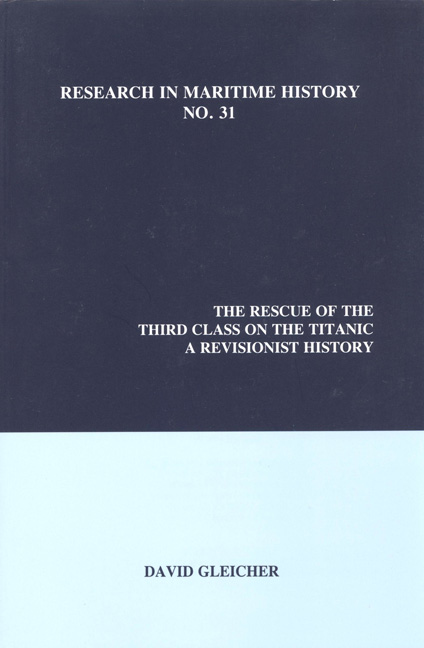Book contents
- Frontmatter
- Dedication
- Table of Contents
- List of Tables in the Text
- List of Illustrations
- Preface
- Notes on the Text
- Introduction
- Chapter 1 The “Popular Story”
- Chapter 2 The Nature Theatre of Oklahoma
- Chapter 3 Except the Rules
- Chapter 4 Departures
- Chapter 5 Like Wild Beasts Ready to Spring
- Chapter 6 Loose Ends
- Chapter 7 A Statistical Study
- Chapter 8 In Conclusion
- Appendix 1 Groupings of Nationalities into Regions
- Appendix 2 Routes to the Lifeboats
- Appendix 3 Deck Plans
- Bibliography
Chapter 5 - Like Wild Beasts Ready to Spring
- Frontmatter
- Dedication
- Table of Contents
- List of Tables in the Text
- List of Illustrations
- Preface
- Notes on the Text
- Introduction
- Chapter 1 The “Popular Story”
- Chapter 2 The Nature Theatre of Oklahoma
- Chapter 3 Except the Rules
- Chapter 4 Departures
- Chapter 5 Like Wild Beasts Ready to Spring
- Chapter 6 Loose Ends
- Chapter 7 A Statistical Study
- Chapter 8 In Conclusion
- Appendix 1 Groupings of Nationalities into Regions
- Appendix 2 Routes to the Lifeboats
- Appendix 3 Deck Plans
- Bibliography
Summary
Life at the Top
We return now to the “exceptional” Third Class men, last seen in chapter 2, who made it up to the Boat Deck from their forward quarters well before the third phase. These men were close at hand as lifeboats were being loaded and launched from the after end between 1 and 1:30 AM and Collapsible C at 1:40. The ship authorities, notably Officers Lowe and Moody, Purser McElroy and all three of the senior officers, came into close contact with them.
The Third Class men in question comprised three groups: 1) single men from the forward quarters who had gone directly to the forward Boat Deck during the first and second phases, never making the “fatal journey” to the stern; 2) those relatively few men quartered in the stern, such as Pickard, as well as perhaps men quartered in the forward end who made it back to the stern early - who promptly went up to the after Boat Deck prior to access to it being cut off; and 3) men who during the second phase made it to the after Well Deck from the stern and then climbed cables from the after Poop Deck to the Boat Deck. We cannot say with any precision how many men were in each group, but the first was by far the largest. The time and place of greatest opportunity for Third Class men to get to the Boat Deck was immediately after the accident at the forward end. Moreover, virtually all the surviving Third Class men whose route to the Boat Deck is known, such as Abelseth and Buckley, were in this group, with the exception of Pickard. The larger question is how many men there were on the Boat Deck and A Deck during the third and fourth phases when the eight lifeboats were being loaded and launched from the after end and when Collapsibles C and D left from the forward end.
We know that roughly sixty Third Class men made it into boats (table 3), all but about ten of them during the third and fourth phases.
- Type
- Chapter
- Information
- The Rescue of the Third Class on the TitanicA Revisionist History, pp. 161 - 202Publisher: Liverpool University PressPrint publication year: 2006



